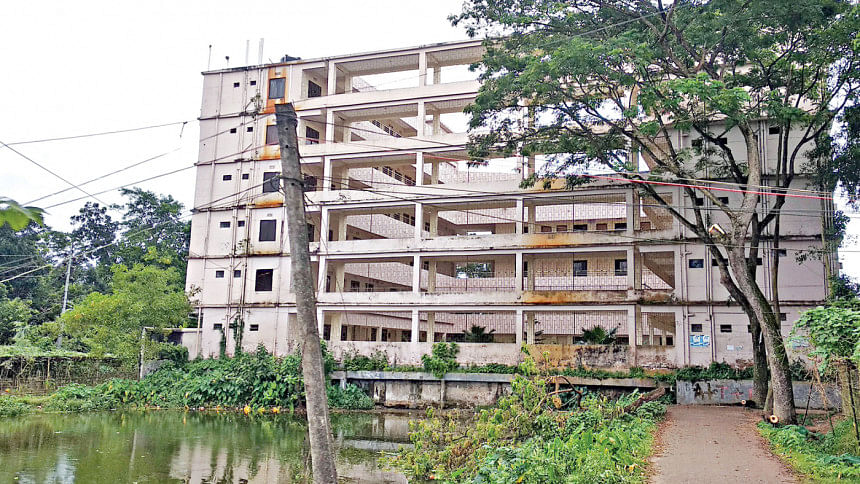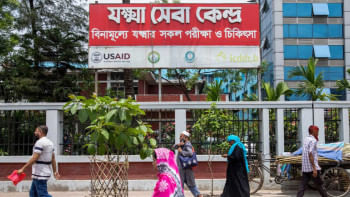Killing Old Khowai River: They are all in it together

It is called Old Khowai and as if to justify its name, it is on its deathbed being deserted by all.
For decades, the water body in Habiganj has been encroached upon by various government establishments and locally influential people belonging to both the Awami League and BNP.
Even a massive drive conducted last year could not yield much result as several of the buildings demolished then have been rebuilt with the land re-occupied.
Besides, a list of illegal occupants drawn up by the district administration in Habiganj town remains undisclosed though it was prepared a year ago.
The list includes influential locals as well as many government bodies which have set up offices and other buildings on this illegally occupied river land, say district administration sources.
While there are allegations that the number of illegal occupants is at least 2,000, environmentalists say only 83 have been mentioned in the district administration's list sent to the National River Conservation Commission.
Tareq Mohammad Zakaria, additional deputy commissioner (revenue) in Habiganj, told this correspondent on Tuesday that the list sent to the River Commission was not complete.
He admitted that there are more than 2,000 illegal occupants.
The list has not been published as part of a strategy of the district administration to keep these occupants from going to the court and trying to get stay orders, he added.
In the drive between March and September last year, a mobile court of Habiganj district administration in association with the Water Development Board demolished around 500 illegal structures built on the river land.
But when this correspondent last month visited the area where the demolitions took place, it was found that some of the buildings have been rebuilt and there are even "to-let" signs on them.
According to Khowai River Waterkeeper Tofazzal Sohel, a local activist, prominent structures that remain on the river land include the Habiganj District Council office, the multi-storey Diabetics and General Hospital, the District and Town Freedom Fighters' Sangshad, a government library, and buildings of other government and non-government institutions.
THE ILLEGAL OCCUPANTS
Red crosses have been drawn on buildings to mark structures built illegally on river-occupied land. One such sign marks the house of Sirajul Haque Chowdhury.
He is the public prosecutor of the District and Sessions Judge's Court of Habiganj and former vice president of the district Awami League.
Contacted, Sirajul said he and around 100 freedom fighters formed the Motsyajibi Samity, which was given permission to build a freedom fighters' housing project there.
Tofazzal Sohel said some of this river land was given to these freedom fighters and other such institutions but they took advantage of it and further encroached upon the river over the years.
Another illegal occupant as per the district administration's list is former Habiganj municipal mayor and joint convener of Habiganj district BNP GK Gaus, sources say.
Contacted, GK Gaus denied illegally occupying any river land.
On visiting Habiganj district town last month, this correspondent found several workers rebuilding an office of Krishak League, a pro-AL organisation, occupying land of the Old Khowai in Anantapur.
This is the same area where the district administration's drive took place last year.
SA Mahfuz, joint secretary of the district Krishak League, is alleged to be involved in the construction of the office.
Contacted, he claimed this will be a temporary office, and if the administration demolishes it in the future, then they will move to some other lace.
He admitted that the office was knocked down at the site last year.
The six-storey Diabetics and General Hospital, right at the mouth of the now-diminished Old Khowai river, looms over the surrounding river land.
Shahid Uddin Chowdhury, president of the board of directors of the hospital, said, the site of the non-profit organisation was registered following proper government procedure.
SAVING THE OLD RIVER
The river was one of the town's reservoirs, Tofazzal said, but it has become almost non-existent because of continued encroachment.
This land grabbing dates back to when the river was diverted.
Around 40 years ago, the Khowai would frequently overflow, flooding the town of Habiganj.
To protect against flooding, the river's natural course was diverted from Mashulia to Rampur and from Khowai Mukh to Garur Bazar through loop cutting at two points.
It was around 250-300 feet wide and 25-40 feet deep before the diversion, said Tofazzal.
After the diversion, the new channel has become the main river which flows around the city. The original river, now landlocked, has become known as Old Khowai.
At least four kilometres of the Old Khowai has been gradually occupied and thus it largely disappeared, he said. The remaining one kilometre has some stagnant water in places, but even in these submerged parts, signboards stand claiming "ownership".
Habiganj WDB's Executive Engineer Shahnewaz Talukder said a project worth Tk 89 crore was sent to the ministry concerned for beautification of the Old Khowai after the drive last year. If the project is approved by Ecnec, necessary steps will be taken.
Sharif Jamil, general secretary of Bangladesh Paribesh Andolon's (Bapa) central committee, said recovering the Old Khowai is crucial to saving Habiganj town from waterlogging and important for the groundwater table of the municipality area.
Unfortunately, locals and civil society of Habiganj who want the channel to be rejuvenated were not engaged with the proposed beautification process. "This is unacceptable," he said.
Plans for the river cannot be drawn up solely by government officials. "It is the people's property and the government is the custodian."
The authorities concerned must share their plans with the people and do the needful to demarcate the river area, evict the land grabbers, and restore the Old Khowai through a comprehensive and inclusive action plan immediately, Sharif added.
Muzibur Rahman Howlader, chairman of the National River Conservation Commission, told this correspondent on Tuesday that the issue has been discussed several times.
"I have issued instructions in a meeting a few days ago. I have requested the DC. They have to do it. The River Commission does not have the power to conduct drives against illegal structures. We can only recommend."
"But," he added, "this is an ongoing process and it is not possible to do it in a short time."
He observed that the government has occupied land of several other rivers in different areas of Bangladesh, not only the Khowai. "They do not have in mind that the rivers must be protected."

 For all latest news, follow The Daily Star's Google News channel.
For all latest news, follow The Daily Star's Google News channel. 



Comments